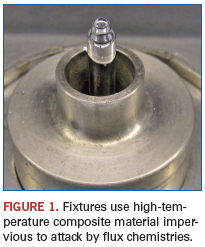Clearing Up Dross
Periodic pot emptying and cleaning, plus nitrogen use, helps reduce dross formation.
In the selective soldering process, dross can be detrimental. Dross (the term as used here encompasses all surface contamination) is created in conjunction with the presence of oxygen in two different areas of the process, and by separate means. Each must be dealt with differently to prevent problems.
Conventional dross, as most people know it, is created when the solder basically tumbles back into the solder pot from the nozzle. As the solder flows back into the pot, down the drop area from the nozzle tip, it mixes with the atmosphere and oxidizes to create a chowder-like substance known as dross. This dross is usually a combination of oxidized solder alloy and spent flux. In Pb-based alloys, dross typically floats on top of the solder in the tank and doesn’t cause any particular problems. The high density of the Pb-based alloy (e.g., Sn63) ensures it remains on top and won’t be drawn down into the pump, clogging the nozzle, or comingling with fresh solder being deposited on the board.
A second type of dross is created by the spindle of the impeller pump driveshaft as it rotates in molten solder. This is actually the product of the metal-to-metal contact (even though the solder is liquidous), the product of essentially a burnishing operation, a rubbing and scrubbing of the metals. The rotating shaft creates an interaction with the molten solder and generates a residue, typically a SnPb oxide or a tin oxide, and it evidences itself in the form of a fine black powder that floats on top of the solder and around the drive shaft.
This black powder-like material can be detrimental to lead or Pb-free soldering because it can be drawn into the pump. As the spindle of the impeller rotates, depending on the volume of this black residue, the rotation can set up a vortex, or whirlpool, during which time the material can be sucked into the impeller area. It then gets into the pumped solder as it is being delivered into the nozzle. It tends to collect, and therefore can contribute to the clogging of nozzles, especially small ones. The smaller the nozzle, the more susceptible it is to clogging with this material. Moreover, that black particulate matter, present in the solder flow, can also deposit itself onto the board, even into the solder fillet itself. This is a concern not only in selective soldering, but also in wave soldering, and in both instances is a product of the pumping process.
To mitigate these issues, solder pot and pumping assembly can be enclosed and the area above the solder and below the cover filled with superheated nitrogen. The nitrogen is permitted to escape only from the area surrounding the nozzle. Doing so inerts the entire solder delivery process, and the return area of the solder to the solder pot, and can sharply reduce conventional dross formation. Black powder dross can be mitigated with nitrogen or the use of protective graphite sleeves around the pump shaft, which act as a barrier, protecting the rotational effects of the pump impeller from interacting with molten solder.
When using Pb-free alloys, dross can be a little more problematic, due in part to the lower density of the Pb-free alloy. For instance, a wrench will float on top of a solder pot full of Sn63, but it will quickly sink to the bottom of a pot of Pb-free alloy. Contamination that typically floats on a solder pot filled with Pb-based alloy, and is therefore easy to remove, may not float on top of a pot of Pb-free alloy, and can drop to the bottom and comingle with the pumped solder. It is imperative to ensure that the surface of the solder is clean daily, and pull the pump assembly and clean the bottom of the solder pot at least four times as often as one would with a pot of Sn63.
It’s easy to test the effectiveness of this nitrogen-inerting approach. We perform a fairly simple empirical test to confirm nitrogen purity and performance and its effects on the wave. We simply tin the nozzle, set the appropriate level of nitrogen purity and flow, and run the flowing solder at full production readiness for a 15-min. interval, during which time we observe the operation closely. We’re not soldering a board at this time, but actually running in free air, with the nitrogen surrounding the nozzle. If no discoloration of the flowing solder is observed, we know that the volume and purity setting of the nitrogen is sufficient to protect that nozzle and mitigate the dross.
Typically, at the end of an 8-hr. shift, one may expect to find about a tablespoon of residue floating on top of the solder pot. It’s largely spent flux mixed with a little dross, and that’s normal and also usually easy to remove. Dross in the bottom of the pot, particularly when using Pb-free solders, can be removed only by emptying the pot. The interval can be determined by the user. In the beginning, more often is better; if, upon inspection of the emptied pot, it can be prudently determined that the frequency is too great (little or no residue), then that PM interval can be increased, provided of course that throughput volume remains mostly static.

Alan Cable is president of A.C.E. Production Technologies (ace-protech.com); acable@ace-protech.com.





